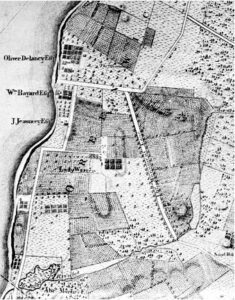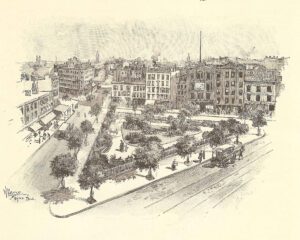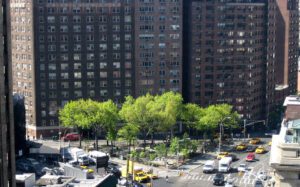The Beginning

The triangular shape of Jackson Square Park has a long, even ancient, history. In many instances the Dutch, and then the English, built colonial roads on top of Native American footpaths. In this instance what is now Gansevoort Street was a footpath that led to a river trading post they called Sapohanikan. This footpath connected with what is now Greenwich Avenue. Although truncated in the 19th century and no longer directly connecting with Greenwich Avenue, Gansevoort’s parallel offspring, Horatio Street, forms the southern base of the triangle. A very assertive 8th Avenue was driven down through the intersection after the Commissioner’s Plan of 1811 imposed a grid system on everything in Manhattan north of 14th Street.
What’s in a name?
The earliest reference found of the park is in the New York Times in 1853. We know that shortly after Andrew Jackson’s death in 1845 what was known as Corlears Park started to be referred to as Jackson Park in honor of the late president. Between 1859 and 1863, members of the Mozart Hall Democratic organization held their gatherings at Jackson Hall, a building that formerly stood at 2 Horatio Street on the corner of Greenwich Avenue. “Jackson Square” appears and is detailed in the Second Annual Report of the Board of Commissioners of the Department of Parks in 1872. According to the report, Jackson Square was one of twenty-nine properties mapped and improved as parkland by the City. By May 1872, Jackson Square saw the following improvements: “5,900 square feet walks graded/103 cubic yards masonry in foundations/460 lineal feet railing/462 lineal feet coping/6 lamp-posts furnished and set.” It remained an enclosed, Victorian “viewing park” from 1872–1888.
Gaining Access

In 1887, Mayor Abram S. Hewitt promoted a city-wide effort to improve public access to the parks and squares that were entirely enclosed by iron fencing. Parks superintendent Samuel Parsons Jr. and consulting architect Calvert Vaux collaborated on a new design for Jackson Square. In an 1892 article for Scribner’s Magazine, Parsons described the central area as “a great bouquet of brilliant flowers and leaves.” He noted proudly, “The neighborhood of this park is respectable but populous, and it is wonderful on a warm evening to see the dense masses of people that crowd the park benches and smooth asphalt walks.”
West Village Life

In 1913, Parks gardeners planted a new school garden plot at Jackson Square and left its upkeep to the “little farmers” in the neighborhood. The park underwent renovations in the 1930s, when seventeen pin oaks were planted on the perimeter, the shower basin was replaced by a new wading pool, and new benches were installed. The park remained substantially unchanged for over fifty years, until a major capital reconstruction project was completed in 1990. It included planting new greenery and restoring the historic iron fencing and benches. The centerpiece—a new cast-iron fountain with planters and a granite base—evoked the 19th-century origins of Jackson Square Park. In 2008, the Jackson Square Alliance, a 501c3 non-profit organization, was formed to maintain the Square and its environs. And in 2019, another major reconstruction of the park updated its infrastructure, increased electricity capacity, made the paving stones and benches ADA-compliant, and renovated the central fountain.